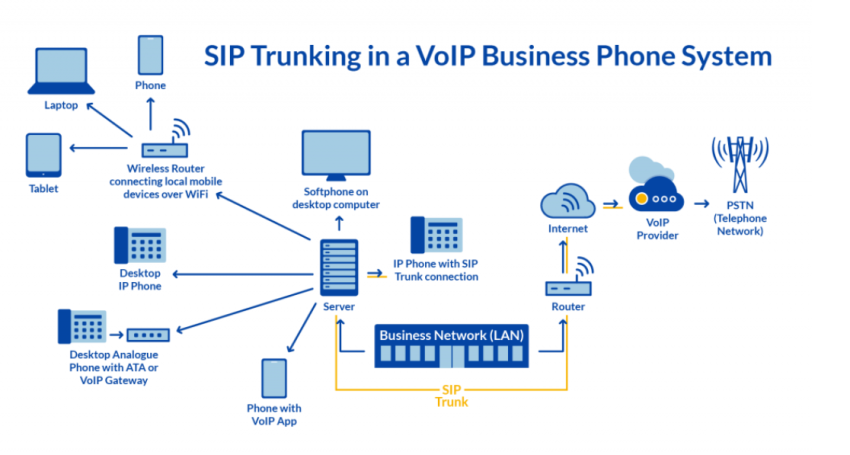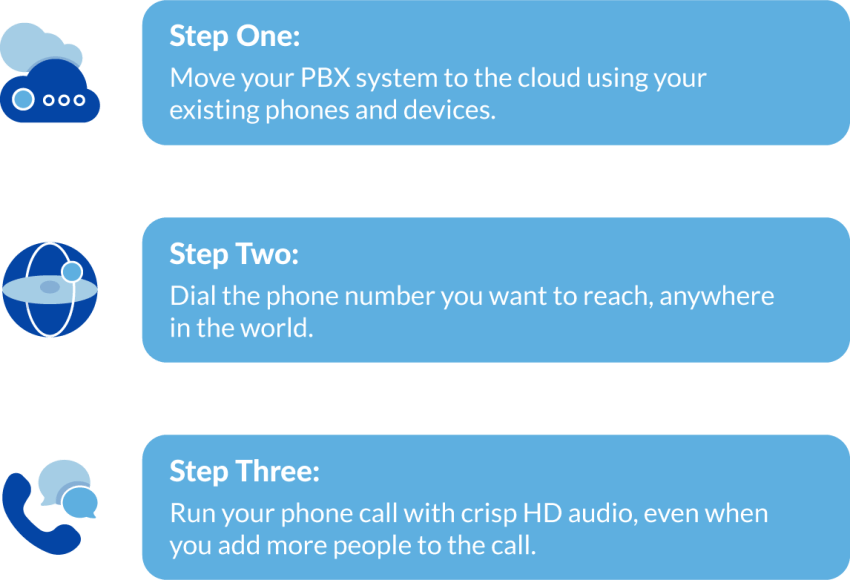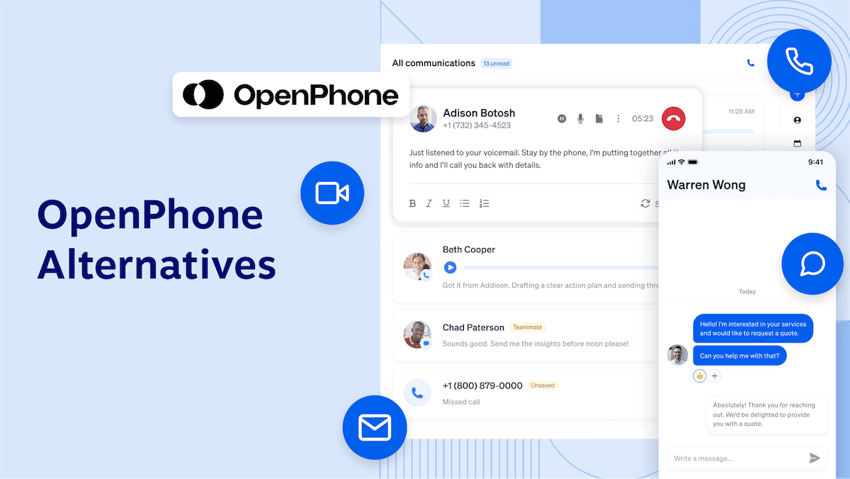Upgrading business phone systems can be daunting when balancing costs and capabilities.
SIP lines and SIP trunking provide affordable ways to upgrade from traditional landline systems, removing reliance on outdated technology like public switched telephone networks (PSTN) and physical lines for business communications.
While traditional PRI and analog lines only process voice data and offer limited features, SIP solutions enable voice, video, instant messaging, and more over a company’s existing internet infrastructure through internet telephony.
SIP trunking specifically allows large call capacity scaling through a single conduit, cost-effectively meeting evolving business needs without requiring on-premise infrastructure.
It helps to know what each offers so you can choose the solution that fits your business needs.
In this article, we’ll discuss SIP lines and SIP trunks and the key differences between them. We’ll also discuss how these solutions can affordably upgrade communications for evolving business needs.
What Is a SIP Trunk?
A session initiation protocol (SIP) trunk refers to a communications medium that connects a company’s private branch exchange (PBX) or PABX to the web. It works like a digital version of the traditional phone line.
As its name suggests, a SIP trunk is analogous to a tree trunk that can have many branches. Each branch represents a unique line or a phone extension.

Many SIP lines can share a single SIP trunk.
For example, a company can have one SIP trunk that can support many desktop phones, softphones, and mobile phones. Each phone call uses a single line that consumes a certain amount of bandwidth.
What is SIP trunking?
SIP trunking is a method used to enable business phones to work over an internet connection instead of a traditional landline. Technically, it also broadens the multimedia processing capabilities of both plain-old telephone service (POTS) and basic Voice over Internet Protocol (VoIP) enabled phone networks.
SIP trunking allows companies to transmit and receive different types of data, including voice calls, text, and video.

A SIP trunk is different than a SIP phone. A SIP phone is a device (like a desk phone or speakerphone) that can establish phone calls via the SIP protocol.
It can be considered a quantum leap in the field of business communications. That’s because of its radical benefits when it comes to cost savings, scalability, flexibility, and return on investment.
What Is a SIP Line?
A SIP line refers to a branch that comes from a SIP trunk. It’s also called a channel or a session. SIP lines act as lanes for exchanging communication data between two points or locations.
In a call session, a SIP line represents a unit’s capacity to support one incoming or outgoing call.
A large number of SIP lines can be configured from a single SIP trunk. In VoIP call centers, one SIP trunk can hold hundreds of SIP channels. Each call takes up one channel. As such, most businesses generally need just a single SIP trunk to cover all their communication needs.

The exact number of SIP lines a company requires depends on the average number of concurrent calls it handles at any time in the workday.
Depending on the service provider (ITSP), a company can have a SIP trunking plan with:
- Unlimited SIP lines
- A fixed count of SIP lines with unlimited minutes
- A number of session minutes that can be distributed across an unlimited number of channels
- Multiple trunks for multiple offices where all users are on the same calling network
SIP Line vs. SIP Trunk
It’s easy to confuse SIP trunks with SIP lines. They can be interchanged in some contexts.
A SIP line connects a single phone or device to make VoIP calls over the internet. It enables one device to make and receive calls.
A SIP trunk connects an entire business phone system or PBX to a VoIP provider. It lets the whole internal phone network make and receive calls over the internet.

Capacity
- SIP Line: Allows one device to make/receive calls.
- SIP Trunk: Allows multiple devices/phones to make calls simultaneously. A SIP trunk is one-to-many while a SIP line is one-to-one.
Features
- SIP Line: Basic call capabilities for a single device.
- SIP Trunk: Enables features like call routing, IVRs, and call handling/transferring, through the business PBX. The intelligence sits with the phone system rather than the end device.
Scalability
- SIP Line: Adding lines is tedious as each device needs its own line.
- SIP Trunk: Easy to add more phone lines as a business grows by simply adding more phones to the existing PBX/SIP trunk.
How To Choose Between SIP lines and SIP trunks
SIP line supports one incoming or outgoing call at a time and is ideal for small businesses with low call volume. If you rarely have more than one or two calls happening simultaneously, SIP lines offer a simple and cost-effective option.
They’re also easy to scale. You can add individual SIP lines as your needs grow. But it may require additional hardware. You might need an IP-PBX system to manage calls across multiple lines.
SIP trunks can carry multiple concurrent calls (usually 10-30 or more) and are best for businesses with higher call volume. If you frequently have multiple employees on the phone, a SIP trunk offers more efficient use of your internet bandwidth.
It’s also highly scalable. You can easily increase the number of channels within your trunk as your business grows. Plus you don’t need additional hardware. Your VoIP provider handles call management.
| Feature | SIP Lines | SIP Trunks |
|---|---|---|
| Number of concurrent calls | One per line | Up to 30+ per trunk |
| Ideal for | Low call volume businesses | High call volume businesses |
| Scalability | Add individual lines | Increase channels within trunk |
| Hardware | May require IP-PBX | No additional hardware needed |
Consider the following when choosing between SIP lines and SIP trunks:
- Cost: SIP lines are generally cheaper per line, but SIP trunks can be more cost-effective for businesses with many concurrent calls.
- Reliability: Both options rely on your internet connection for call quality.
- Features: SIP trunks often offer additional features like call forwarding, voicemail, and conferencing.
Benefits of SIP Trunking
It’s only a matter of time until landline phones will become obsolete. Because you don’t want your business to go down with outdated technology, making the right investments now matters. With pretty much everything going digital, SIP trunking can help you thrive in the new economy.
1) Easy Setup/Low Maintenance. You don’t need physical phone lines and other hardware to install and maintain a SIP trunk. A reliable internet connection will do.
2) Affordability/Lower Costs. SIP trunks can reduce phone service expenses significantly. In-network calls, as well as long-distance domestic calls, are free. Meanwhile, international calls cost a fraction of traditional fees.
3) Scalability. Getting extra SIP lines is much easier than having a SIP trunk installed. All you have to do is inform your SIP provider — no need for additional hardware
4) Dependability. SIP trunks allow for better risk management through service redundancy and reliability. For example, you can have calls forwarded to secondary phones when a rare internet outage occurs.
5) Enhanced Customer Service. SIP trunking gives you a full range of multimedia and unified communications capabilities. This can improve sales, marketing, and customer service. In addition to voice services, you can include SMS texting, file sharing, and web conferencing in the package.
Although a better solution, since SIP trunks rely on the public internet, you risk call quality issues or failed calls due to bad network connectivity. You also need to account for potential security issues, dependency on broadband, and power failures.
Make sure to assess the potential drawbacks and mitigate them by setting up better security measures, firewalls, power backup options, and above all, choosing the right VoIP provider.
Before You Choose SIP….
SIP trunking is an excellent investment for your team’s productivity. But not all SIP trunk services are the same.
When evaluating SIP trunking providers for your VoIP phone system or VoIP phone service, be sure to consider factors like reliability, scalability, and features.
To get the best deal for your business, here are tips to evaluate and select a SIP provider:
- Audit your existing business communications network. Take stock of your current phone system and infrastructure. Are you already using VoIP technology or still relying on older POTS copper lines? An upgrade may be in order.
- Clearly define your business communication goals and requirements. Think about your expected headcount growth, plans to open additional office locations, and desired functionality like video conferencing, call center features, mobility needs, etc. This will help match your needs to the provider’s capabilities.
- Identify the most important evaluation criteria to guide your selection process. Examine aspects like specific VoIP features offered, pricing models and scalability, call quality assurances, security protocols, customer reviews, breadth of customer support, geographic coverage areas, and integration with your other systems and devices.
- Ensure you have a compatible PBX phone system installed. A SIP trunk connects to your backend Private Branch Exchange (PBX) system that manages call routing and functions. Choose a SIP provider that integrates well with your existing hardware/software PBX platform.
- Research and compare multiple providers under consideration. Read third-party review websites like GetVoIP, Software Advice, and G2 to evaluate the reputation and capabilities of each. Reach out for demos, quotations, and trials.
- Thoroughly evaluate each prospective vendor. Go beyond assessing the service fees alone to consider the overall value of the partnership you are entering into. Test their customer service response time and knowledge. Assess how flexible they are to grow with your evolving needs.
- Make an educated, informed provider choice that aligns with your telephone needs and budget. Don’t just select the cheapest option without weighing factors like features, reliability, and long-term support. Take your time to choose the right SIP trunking service provider.


















 VoIP
VoIP 











